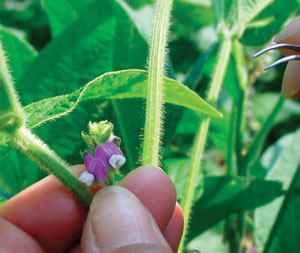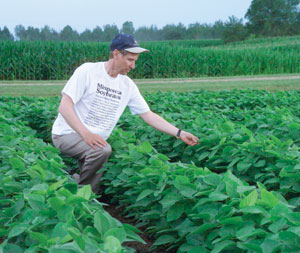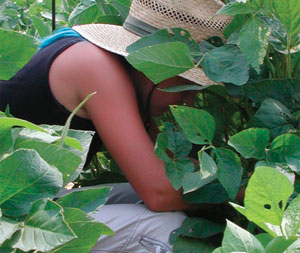Breeding Better Beans




January 1, 2008
BY Jessica Ebert
A native to the Far East and a cultivated crop there for more than 3,000 years, the soybean is a relative newcomer to the United States. First introduced in the 1770s, soybeans were initially grown for forage. It wasn't until the mid-1900s that the first U.S. cultivar was released. Although hundreds of domestic varieties have become available to farmers since that time, the genetic diversity of these lines is disturbingly narrow. "If you trace the pedigrees back, there are about six ancestral lines that contribute more than 50 percent of the genes to the varieties which we currently grow in the U.S.," explains Randall Nelson, a soybean geneticist for the USDA Agricultural Research Service at the University of Illinois. "That's not very much."
When two plants are significantly different in terms of the genes that they can pass on, there is a greater chance that their progeny will inherit a unique or desired trait such as higher yield or increased oil concentration. To increase the genetic diversity of the cultivars available in the United States then, researchers like Nelson introduce genetic material from exotic varieties-from soybeans cultivated or discovered in such places as China, Korea, Japan or eastern Russia. Seeds from these exotics are stored at the University of Illinois in the USDA's soybean germ plasm collection. "This is the collection of the genetic diversity of the soybean and its relatives that we and lots of other people use for research and breeding," says Nelson, who is curator of the collection. Of the 20,000 different soybean varieties in the collection, 17,000 are exotics. "My take on the situation is that we could do better because we have these other 17,000 lines that we haven't used," he says. "This is the genetic diversity that can be used to improve a species."
In addition to his duties as curator, which include maintaining the seeds and helping other geneticists and breeders gain access to the collection, Nelson and colleagues work to develop high-yielding lines that originate-at least in part-from exotic varieties that are currently not being used by anyone else in the country.
The traditional way to improve soybean yields-as with most crops-is to take two high-yielding varieties, cross them, look at the progeny after several generations and see if any provide yields that are higher than the parents. For soybeans, crossing involves taking the pollen from the flower of one plant, placing it on the sticky stigma of another plant's flower and allowing seeds to develop. This hybrid seed called the F1 seed is then planted. Then because soybeans are normally self-pollinating, the plants that grow are allowed to form seeds, which are called F2 seed. Things start to get interesting when this seed is planted because any genetic differences that result from the crossing manifest in this generation. "These plants segregate," says Jim Orf, a soybean geneticist at the University of Minnesota. Some may be taller, some may be shorter, some may mature earlier than others; some may have higher yields or provide seeds with higher oil content or show resistance to agricultural pests. However, it's hard to do anything with individual plants so scientists grow them for several more generations, Orf explains.
Once scientists have enough seed from a single promising parent they plant rows of that variety in several different locations to conduct yield evaluations. These are usually done for two years in the state and another two years regionally before these varieties are released to farmers, Orf says. "We need to do it over several years because we don't know what the weather conditions are going to be like once a variety comes out," he says. "Looking at data from just one year is not going to give you a reliable estimate of how it's going to do over several years. We try to pick those breeding lines that perform at the top for several years in a row."
During the past six or seven years, Nelson and colleagues have released about 15 soybean lines, each with a genetic contribution from an exotic variety ranging from 25 percent to 100 percent. The yield of these varieties is comparable to commercially available lines, however, they aren't yet ready for farmers to use. Rather, these lines become available for breeders like Orf to use as parents.
New Varieties
Orf and colleagues recently released two higher yielding varieties suitable for central and southern Minnesota. The improved performance of these plants is in part due to pest-resistance traits; one variety carries resistance to a fungus called Phytophthora, which causes root rot, while the other is resistant to soybean cyst nematode, which is the single most damaging soybean pest in the United States. Limited quantities of this seed should be available to farmers for the first time this spring, Orf says.
Likewise, Pioneer Hi-Bred International Inc., a DuPont Co. business, focused on developing and commercializing advanced plant genetics, recently announced that the company would introduce five high-yielding varieties for spring planting pending final trial results. These new choices for farmers stem from an advanced molecular breeding technology developed by Pioneer called Accelerated Yield Technology. The technique allows researchers to identify genes associated with high yields and focus development efforts on lines that have those genes. "Full implementation of AYT combined with molecular breeding technologies will enable Pioneer to make a new class of soybeans that has unprecedented yield potential relative to anything we have ever seen," says William Niebur, vice president of DuPont Crop Genetics Research and Development.
The first variety that the company hopes to introduce to farmers this year is an AYT version of the Pioneer brand 94M80, which set the world record soybean yield of 139 bushels per acre in 2006. "These technologies allow us to incorporate a complete package of offensive and defensive characteristics that could make 100-plus bushel soybean yields a common occurrence in the very near future," Niebur says.
High yield and pest resistance are not the only traits that soybean breeders work to enhance. Geneticists and breeders at North Carolina State University have been working for more than 35 years to develop high-oil soybean varieties. The program wasn't originally aimed at generating better lines for biodiesel production, rather the focus of the program was on soybeans that produce more oil per acre," says Joe Burton, research leader and geneticist at the USDA's Soybean and Nitrogen Fixation Research Unit at NCSU in Raleigh. "The growth of the biodiesel industry in recent years is "a happy coincidence."
Through standard breeding techniques, Burton and colleagues have developed several high-oil soybean lines. One, dubbed NC-Raleigh has been available to farmers for about three years. This variety resulted from a cross between a high-oil breeding, or germplasm, line developed by Burton and a high-yielding variety. Since the university has a winter nursery in Puerto Rico, it only took about three years to generate F5 seed. Although the new variety has been the most productive variety in the USDA trials in North Carolina, farmers have been slow to start planting it because it doesn't carry the Roundup Ready gene. This gene provides resistance to the herbicide of the same name, which farmers spray on their fields. "NC-Raleigh just doesn't fit the production systems that farmers have now," Burton explains. "Farmers have gotten accustomed to planting the Roundup variety and spraying with that. That's what they like."
Although the productive NC-Raleigh line may never be widely used as a variety itself, it is used in crosses. "I'm sure the variety is being used as a parent by private and public soybean breeders because it is productive," Burton says. In fact, his team is focusing on that very thing now. The new crosses that Burton's team is doing are between NC-Raleigh and other lines with higher oleic acid content, which has been shown to reduce the pollutants of diesel and biodiesel called nitrogen oxides, or varieties with lower saturated fatty acids, which have been shown to improve the performance of biodiesel in cold weather. "From the biodiesel point of view, we've really just begun this program," Burton says.
Although it's too early to tell what will come of these crosses, it's fair to say that like the exotic lines stored in the Illinois seed bank, NC-Raleigh will likely have more of an impact as a breeding tool than as a variety itself. By using the raw material provided by the best beans of today, soybean geneticists can continue to mix-and-match heritable traits in an attempt to tailor-make the better beans of tomorrow.
Jessica Ebert is a Biodiesel Magazine staff writer. Reach her at jebert@bbibiofuels.com or (701) 738-4962.
When two plants are significantly different in terms of the genes that they can pass on, there is a greater chance that their progeny will inherit a unique or desired trait such as higher yield or increased oil concentration. To increase the genetic diversity of the cultivars available in the United States then, researchers like Nelson introduce genetic material from exotic varieties-from soybeans cultivated or discovered in such places as China, Korea, Japan or eastern Russia. Seeds from these exotics are stored at the University of Illinois in the USDA's soybean germ plasm collection. "This is the collection of the genetic diversity of the soybean and its relatives that we and lots of other people use for research and breeding," says Nelson, who is curator of the collection. Of the 20,000 different soybean varieties in the collection, 17,000 are exotics. "My take on the situation is that we could do better because we have these other 17,000 lines that we haven't used," he says. "This is the genetic diversity that can be used to improve a species."
In addition to his duties as curator, which include maintaining the seeds and helping other geneticists and breeders gain access to the collection, Nelson and colleagues work to develop high-yielding lines that originate-at least in part-from exotic varieties that are currently not being used by anyone else in the country.
The traditional way to improve soybean yields-as with most crops-is to take two high-yielding varieties, cross them, look at the progeny after several generations and see if any provide yields that are higher than the parents. For soybeans, crossing involves taking the pollen from the flower of one plant, placing it on the sticky stigma of another plant's flower and allowing seeds to develop. This hybrid seed called the F1 seed is then planted. Then because soybeans are normally self-pollinating, the plants that grow are allowed to form seeds, which are called F2 seed. Things start to get interesting when this seed is planted because any genetic differences that result from the crossing manifest in this generation. "These plants segregate," says Jim Orf, a soybean geneticist at the University of Minnesota. Some may be taller, some may be shorter, some may mature earlier than others; some may have higher yields or provide seeds with higher oil content or show resistance to agricultural pests. However, it's hard to do anything with individual plants so scientists grow them for several more generations, Orf explains.
Once scientists have enough seed from a single promising parent they plant rows of that variety in several different locations to conduct yield evaluations. These are usually done for two years in the state and another two years regionally before these varieties are released to farmers, Orf says. "We need to do it over several years because we don't know what the weather conditions are going to be like once a variety comes out," he says. "Looking at data from just one year is not going to give you a reliable estimate of how it's going to do over several years. We try to pick those breeding lines that perform at the top for several years in a row."
During the past six or seven years, Nelson and colleagues have released about 15 soybean lines, each with a genetic contribution from an exotic variety ranging from 25 percent to 100 percent. The yield of these varieties is comparable to commercially available lines, however, they aren't yet ready for farmers to use. Rather, these lines become available for breeders like Orf to use as parents.
New Varieties
Orf and colleagues recently released two higher yielding varieties suitable for central and southern Minnesota. The improved performance of these plants is in part due to pest-resistance traits; one variety carries resistance to a fungus called Phytophthora, which causes root rot, while the other is resistant to soybean cyst nematode, which is the single most damaging soybean pest in the United States. Limited quantities of this seed should be available to farmers for the first time this spring, Orf says.
Likewise, Pioneer Hi-Bred International Inc., a DuPont Co. business, focused on developing and commercializing advanced plant genetics, recently announced that the company would introduce five high-yielding varieties for spring planting pending final trial results. These new choices for farmers stem from an advanced molecular breeding technology developed by Pioneer called Accelerated Yield Technology. The technique allows researchers to identify genes associated with high yields and focus development efforts on lines that have those genes. "Full implementation of AYT combined with molecular breeding technologies will enable Pioneer to make a new class of soybeans that has unprecedented yield potential relative to anything we have ever seen," says William Niebur, vice president of DuPont Crop Genetics Research and Development.
The first variety that the company hopes to introduce to farmers this year is an AYT version of the Pioneer brand 94M80, which set the world record soybean yield of 139 bushels per acre in 2006. "These technologies allow us to incorporate a complete package of offensive and defensive characteristics that could make 100-plus bushel soybean yields a common occurrence in the very near future," Niebur says.
High yield and pest resistance are not the only traits that soybean breeders work to enhance. Geneticists and breeders at North Carolina State University have been working for more than 35 years to develop high-oil soybean varieties. The program wasn't originally aimed at generating better lines for biodiesel production, rather the focus of the program was on soybeans that produce more oil per acre," says Joe Burton, research leader and geneticist at the USDA's Soybean and Nitrogen Fixation Research Unit at NCSU in Raleigh. "The growth of the biodiesel industry in recent years is "a happy coincidence."
Through standard breeding techniques, Burton and colleagues have developed several high-oil soybean lines. One, dubbed NC-Raleigh has been available to farmers for about three years. This variety resulted from a cross between a high-oil breeding, or germplasm, line developed by Burton and a high-yielding variety. Since the university has a winter nursery in Puerto Rico, it only took about three years to generate F5 seed. Although the new variety has been the most productive variety in the USDA trials in North Carolina, farmers have been slow to start planting it because it doesn't carry the Roundup Ready gene. This gene provides resistance to the herbicide of the same name, which farmers spray on their fields. "NC-Raleigh just doesn't fit the production systems that farmers have now," Burton explains. "Farmers have gotten accustomed to planting the Roundup variety and spraying with that. That's what they like."
Although the productive NC-Raleigh line may never be widely used as a variety itself, it is used in crosses. "I'm sure the variety is being used as a parent by private and public soybean breeders because it is productive," Burton says. In fact, his team is focusing on that very thing now. The new crosses that Burton's team is doing are between NC-Raleigh and other lines with higher oleic acid content, which has been shown to reduce the pollutants of diesel and biodiesel called nitrogen oxides, or varieties with lower saturated fatty acids, which have been shown to improve the performance of biodiesel in cold weather. "From the biodiesel point of view, we've really just begun this program," Burton says.
Although it's too early to tell what will come of these crosses, it's fair to say that like the exotic lines stored in the Illinois seed bank, NC-Raleigh will likely have more of an impact as a breeding tool than as a variety itself. By using the raw material provided by the best beans of today, soybean geneticists can continue to mix-and-match heritable traits in an attempt to tailor-make the better beans of tomorrow.
Jessica Ebert is a Biodiesel Magazine staff writer. Reach her at jebert@bbibiofuels.com or (701) 738-4962.
Advertisement
Advertisement
Upcoming Events





